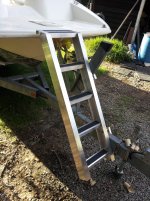Thanks to everyone for the replies. I'm going to have to read and reread the thread to get an understanding of the options presented and decide which way to go. Not much time to go through it right now.
I will try to get the trailer laid out and get pics of the bowing so you can get an idea of where the problem lies, with different angles of pics and such.
I am not trying to get an engineering degree from the internet. I still wish that was the field I had chosen young in life, but there was no money for the schooling at that time. I ended up being a SQL Server DBA, which I like, as long as I can partake in my one of my favorite activities, things involving large machinery and a welder.
The big thing here is I would like to know how to be a bit more scientific about designing and building things so that in cases where size, or weight matters, I can make the right decisions. No, there are no space shuttles or sky scrapers in my future, but some small time engineering so I can build cool things like I see in these forums.
Here's a pic of the boat trailer ladder I designed and built from aluminum this summer. I experimented with that by cutting up an old step ladder and clamping it onto the trailer. After I saw how badly it would twist when a little weight was added, I decided to make it out of 1/8" x 1.5" x 3" channel. It turned out really nice, and clamped in two places on the trailer, is solid as a rock.

Thanks again,
Chris
